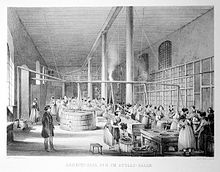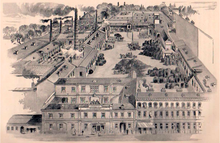First Austrian soap boiler trade union "Apollo"
| First Austrian soap boiler trade union "Apollo" | |
|---|---|
| legal form | Limited Liability Company (Austria) |
| Seat | Vienna |
| Branch | Mixed company |
The first Austrian soap boiler trade union “Apollo” was a soap boiler company in Vienna .
history
In 1833, six Viennese soap makers and united Talgschmelzer , namely V. Böhm, Anton Diedek, Josef Fischer, Joseph Holzhauer, J. Knoll and Josef Schreder to in the former suburb of Vienna Penzing , the outside of the consumption tax - rayons , there was a to erect large sebum melt . The purpose of this foundation was, on the one hand, to introduce a uniform raw tallow purchase price in and outside of the Vienna consumption tax area, and on the other hand, to produce a product by squeezing out tallow, which could replace the expensive wax candles .
In the meantime, the discovery of the French chemist Eugène Chevreul (1825) of breaking down neutral fats into fatty acids and glycerin and converting the former into stearin had already found practical application in France through the establishment of a stearin factory by G. de Milly in Paris in 1831, and Milly & Motard's stearin factory was built in Berlin in 1835.
First Austrian soap boiler trade union
These industrial events aroused lively interest and the desire in the small Austrian society to exploit Chevreul's invention in Austria as well. To this end, the company strengthened itself by accepting new members, Georg Hartl, F. Knoll, Wenzel Mareder and the Perl brothers joined the company that was called the “First Austrian Soap Boiler Trade Society” in Vienna. However, the preparatory work for founding the company and obtaining a license was delayed for so long that the Schrader brothers were granted a kk privilege to produce stearin candles in 1837 and founded a stearin factory in Steinhof near Liesing .
The now licensed “First Austrian Soap Boiler Trade Society” bought the Schrader factory in 1840 and received the first Austrian privilege to manufacture stearin candles.
The factory in Steinhof near Liesing was closed, production was relocated to the Apollo hall in Vienna and the name “Apollo” was chosen as the brand for the product.
Georg Hartl was the technical director. It was mainly thanks to him that the quality of the “Apollo” brand soon became so popular in the trade that other large stearin candles , which were made in Holland , Belgium and Germany in the meantime, imitated the company's trademark and the original orange-colored packaging of the candle packages. Georg Hartl was constantly striving for technical improvements, which came from France in particular. In 1845, at the first Austrian industrial exhibition in Vienna, the "Apollo candles" were awarded the highest golden honorary prize.
As a result of the steadily growing sales of Apollo candles, the company expanded its production facilities from 1850. Following the Talgschmelze in Penzing, a branch was built and production continued in the Apollo hall especially for Viennese needs, while the branch factory produced for export. The oleic acid produced as a waste product was used in the manufacture of soap . The "Apolloseife" formed a new important industrial product. The "Apollo" brands have been awarded first prizes at all important world exhibitions.
In 1860 a new field opened up for the stearin industry, the extraction and recycling of the by then almost worthless waste product, glycerin . In 1862 the Penzing factory began to extract raw glycerine. With the distillation of raw glycerine with superheated steam from 1872, the production of those types of glycerine was made possible, which were used in pharmacy and in various technical trades, especially for the production of nitroglycerine .
When in 1870 the French chemist Hippolyte Mège-Mouriès , by Emperor Napoleon III. initiated, invented the production of margarine and synthetic butter and a new industry developed from this invention, the "First Austrian Soap Boiler Trade Association" also started this production in 1876. "Apollo" margarine was exported to Holland and Germany. The production of artificial butter was started in 1875, but was not an economic success because of rejection by the consumers.
In 1876 a fire completely destroyed the Apollo Hall. The company transferred production to the suburb of Simmering . At the same time, a second margarine factory was built in Simmering. The stearin factory in Simmering, which was partially destroyed by fire in 1886, was rebuilt in a few months.
First Austrian soap boiler trade union "Apollo"
In 1891 the members of society F. Fischer (Messrs. Felix and Max Fischer) and G. Hartl & Sohn (Mr. Carl Hartl) in Vienna saw the merging of the suburbs with Vienna, prompted them to set up their soap, candle and perfumery factories in Vienna ( Landstrasse , Ottakring , Rossau and Simmering) to be closed and to unite with the "First Austrian Soap Boiler Trade Society". On this occasion, the name of the company was changed to "First Austrian soap boiler trade association" Apollo "".
A thorough technical reorganization of the two factories in Penzing and Simmering became necessary. A large new building in the Simmering factory was used for soap production, the stearin and stearin candle production was left in Penzing and, like the perfumery production, was technically state-of-the-art.
At the end of the 19th century, the factory in Simmering dealt exclusively with the production of stearin and stearin candles and all common textile and household soaps , while the factory in Penzing with the production of margarine, margarine butter , margarine lard , the glycerin refinery and distillation and perfumery manufacturing. In the two factories, 15 steam boilers with a total of around 1,100 square meters of heating surface provided the necessary energy, and six steam engines with a total of around 250 hp provided the motor power.
The stearin factory was able to process all common raw materials, with or without distillation of the fatty acids, as required. "Apollo candles" were made exclusively from the purest stearic acid. A wick factory of its own produced the wicks required for the candles. The Emballagekisten were invariably supplied by the own steam joinery.
In the soap factory, the soap was boiled both with steam and with direct fire, for this purpose two steam boilers with a capacity of 44,000 liters each were installed.
The margarine factory was engaged in the production of margarine from raw tallow. Some of the product was further processed into margarine butter and margarine beef lard in-house, which was also exported to Holland and Germany. The margarine butter factory was set up on the model of the Dutch system of the largest local margarine butter factories.
The glycerine refinery and distillation produced all commercially available types of glycerine and had been able to survive the tough competition against German glycerine.
The perfumery factory produced toilet soaps and perfumes with continuously increasing sales. Around 1900 the company employed around 600 workers and around 60 civil servants. Long before the statutory workers' health insurance came into force , sick workers were supported by society, and in 1885 a factory health insurance company was founded. All civil servants and workers who were unable to work due to old age received pensions .
In 1898 the participants of the society were Carl Diedek, Felix Fischer, Max Fischer and Karl Hartl. Carl Diedek, as the company's public partner, was appointed supplier to the imperial and royal court .
The company was taken over by the Shift AG in 1911 , the independent name existed until 1939.
Individual evidence
- ↑ a b c d e f g h i j k l m n o p q r s t u v w First Austrian soap boiler trade association “Apollo” . In: Presented by the industrialists of Austria under the high protectorate of His K. and K. Highness of the Most Serene Archduke Franz Ferdinand (Hrsg.): Die Groß-Industrie Oesterreichs . Festival ceremony for the glorious fiftieth anniversary of the reign of His Majesty the Emperor Franz Josef I. Volume 6 . Leopold Weiss, Vienna 1898, XIII. Chemical industry, p. 37-38 .
- ↑ Handbook of the Supreme Court and the Court of His K. and K. Apostolic Majesty . Kk Hof- und Staatsdruckerei , Vienna 1899, p. 350 .
- ↑ Werner Kohl: "Apollo" candle and soap factory and Unschlittschmelze Vienna XIV. (PDF; 4.1 MB) (No longer available online.) Althofen.at, archived from the original on June 6, 2016 ; Retrieved October 7, 2011 . Info: The archive link was inserted automatically and has not yet been checked. Please check the original and archive link according to the instructions and then remove this notice.
literature
- Hans Hornácsek (Ed.): First Austrian soap boiler trade union "Apollo", 1839-1899 . Self-published. Printed by Josef Eberle, Vienna, First Vienna Newspaper Society. Vienna 1899.
- Industrie-Compass 1919 Volume I.
- Industrie-Compass 1924/25.
- Alois Brusatti : History of Unilever Austria . Self-published. Wiener Verlag, Himberg near Vienna, 1985.
- Gunther Pauls: From "Oil Sweet" to Margarine - From the Beginnings of the Austrian Fat Industry to World War II . Ed .: Kuner Nahrungsmittel, Vienna 1999.
- Gebhard Klötzl: The factories of the Wiental . In: Penzinger Museum Papers . Issue 61. Ed .: Museumsverein Penzing. Vienna 2002.
- Hietzing. A home book of the 13th Viennese district . 2. Volume From Past and Present . Ed .: Working group for local history in Hietzing Austrian Federal Publishing House for Education, Science and Art, Vienna 1932.






